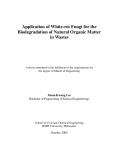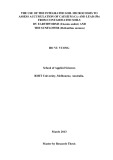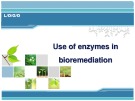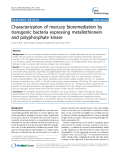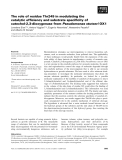
Bioremediation
-
Biostimulation (kích thích sinh học ) Bioaugenzymetation (tăng sinh học ) - nuôi cấy sinh khối trong dạng hạt ở các bể phản ứng sinh metan -công nghệ DNA tái tổ hợp
 43p
43p  htc_12
htc_12
 13-05-2013
13-05-2013
 171
171
 23
23
 Download
Download
-
The research herein builds on the work of Rojek (2003) and further investigates the bioremediation of NOM wastes. The aim of this research was to evaluate the effectiveness of selected white-rot fungi and yeast for the biodegradative removal of concentrated NOM from solution. The effectiveness of the white-rot fungus P. chrysosporium ATCC 34541 for the biological degradation of different batches of MIEXTM NOM concentrate and the effects of different characteristics of the NOM on the process and thus the resistance of the NOM to microbial removal were investigated.
 131p
131p  runthenight05
runthenight05
 01-03-2023
01-03-2023
 13
13
 3
3
 Download
Download
-
In this study the earthworm Eisenia andrei and sunflower dwarf sensation (Helianthus annuus) were used as tools to accumulate Pb and stable Cs. The aim of this study was to evaluate bioremediating Cs and Pb in contaminated soils using the selected biota. The efficacy of this bioremediation was evaluated using integrated soil microcosms (ISM)–a multispecies mini ecosystem with soil contaminated with Cs alone at 25 mg/kg and 250 mg/kg; Pb alone (1500 mg/kg) and Pb (1500 mg/kg) together with Cs (250 mg/kg) in the laboratory.
 154p
154p  runthenight07
runthenight07
 01-03-2023
01-03-2023
 7
7
 4
4
 Download
Download
-
Bài thuyết trình: Use of enzymes in bioremediation trình bày các loại ô nhiễm môi trường, phục hồi sinh học, các phương pháp phục hồi sinh học,... Tham khảo nội dung tài liệu để nắm bắt nội dung chi tiết.
 22p
22p  thuyancn
thuyancn
 25-06-2015
25-06-2015
 95
95
 13
13
 Download
Download
-
Bioremediation presents a potentially low cost and environmentally agreeable alternative to current physico-chemical remediation strategies. However, heavy metals such as mercury cannot be converted into non-toxic forms by naturally occurring bacteria. Annual global emissions estimates for mercury released into the environment are in the thousands of tons per year [1,2] while the remediation cost is in the thousands of dollars per pound. Finding new bioremediation technologies is an urgent need.
 8p
8p  zingzing09
zingzing09
 24-04-2013
24-04-2013
 48
48
 4
4
 Download
Download
-
Bioremediation strategies use microorganisms to remove hazardous sub-stances, such as aromatic molecules, from polluted sites. The applicability of these techniques would greatly benefit from the expansion of the cata-bolic ability of these bacteria in transforming a variety of aromatic com-pounds.
 14p
14p  inspiron33
inspiron33
 25-03-2013
25-03-2013
 37
37
 3
3
 Download
Download
-
Các nhà khoa học Viện Công nghệ Sinh học, Viện Khoa học Công nghệ Việt Nam đã nghiên cứu đề tài tẩy độc đất nhiễm nặng chất diệt cỏ/dioxin bằng phân hủy sinh học. Máy bay rải chất diệt cỏ/dioxin. (Nguồn: Internet) Đây là đề tài đã được ứng dụng để tẩy độc đất nhiễm nặng chất diệt cỏ/dioxin bằng phân hủy sinh học (bioremediation) ở căn cứ quân sự của Mỹ ngụy cũ tại Đà Nẵng. ...
 7p
7p  heoxinhkute4
heoxinhkute4
 29-09-2010
29-09-2010
 254
254
 92
92
 Download
Download
CHỦ ĐỀ BẠN MUỐN TÌM









